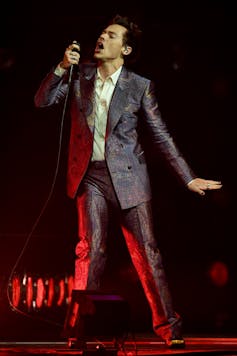The 2017 ARIA Awards are still off-key when it comes to gender
- Written by Catherine Strong, Senior Lecturer, Music Industry, RMIT University
The Australian music industry has spent the last few years taking a long hard look at the position of women in music in this country. And while women such as Amy Shark, Sia and Kasey Chambers did well at the 2017 ARIA Awards on Tuesday night, there was a lot left to be desired.
It’s telling that even the key male winners from the night, including Gang of Youths, Paul Kelly and Harry Styles, were overshadowed by Kirin J. Callinan exposing his genitals on the red carpet, an action that showed extraordinary tone-deafness at a time when men’s inappropriate sexual behaviour in the entertainment industries is under the spotlight.
The damning figures about low representation of women across the industry, whether it be in artist royalties, airplay, representation on boards, or membership of key music organisations have by this point been detailed at summits, conferences and activist events. It is now well established that women are not sharing the benefits of this industry in a way that comes anywhere close to being equal.
We should examine this year’s ARIA awards with this in mind.
And the nominees are…
To begin with, the nominations reveal where women can participate and where their contribution is valued. Across the awards for Australian artists, women or bands with a female member received fewer than one in three nominations in 2017. There’s been no improvement in this measure for the last two years.
These numbers are better than some of the worst years of ARIA nominations this decade, such as 2013 where only nine nominations were given to women for awards outside the Best Female Artist category.
Looking at the categories that women were nominated in provides further insights. There were only four categories out of 18 where women outnumbered men (excluding Best Female Artist). Women had four out of five nominations for Best Pop Release, and three out of five in the Breakthrough Artist category, Best Country and Best Children’s Album. Men outnumbered women in 12 categories where they could both be nominated. In the worst of these, women had no nominations at all in Best Group, Dance Release, Adult Contemporary album or Hard Rock/Heavy Metal album.
This shows the continued fault lines in the industry that see women relegated to certain roles and excluded from others. Pop has long been an area where women do well. Despite recent moves towards a “poptimist” outlook in valuing its worth, the genre has gained the least critical acclaim and has often been dismissed as overly commercial and lightweight.
By contrast, “heavier” forms of music, and those played by bands have been strongly gendered as masculine. While women make up a large proportion of the fanbase for metal and rock, they have struggled to make headway in these genres as performers. At the same time, these are the types of music that are considered more “real”, serious and worthy of taking seriously.
The failure of women to appear in the nominations for dance music highlights another area where women have struggled to make inroads. On the one hand, this shows a continued disconnect between women and music technology, and with technology more broadly.
However, dance music culture has proven more resistant than other areas in music to incursions by women, with dance music festivals having lower representation of women than other types of festivals.
Where to from here?
So in some ways, the distribution of the nominations reflects ongoing issues, with some genres remaining significantly male-dominated. Despite this, questions need to be asked about the ARIA nomination processes that resulted in these four categories having no women. Something is off here, whether it be an issue in the practices of music making that sees women still not allowed into certain spaces, or issues with how awards are handed out.
 Harry Styles was one of the male performers at this year’s ARIA Awards.
AAP
Harry Styles was one of the male performers at this year’s ARIA Awards.
AAP
On the night, the number of winners who were women reflected the proportion of women nominated - six of the 18 awards for Australian artists went to women (including Best Female). Given the nomination pool, this is what might be expected, and again is an improvement on some past years, but it is still unsatisfactory.
Given that we know there is a gender representation problem in the industry, an easy place to start making fixes is to put women on stage at high-profile events, at least as often as their male counterparts.
But similar to the nominations, only a third of the performers at this year’s ARIAs were women. This was one place where ARIA had the ability to do better - especially in the current climate of close attention being paid to issues of gender. A 50-50 split here would have been easy to achieve and would have made a statement about the industry’s commitment to fixing this problem.
This is particularly disappointing in a year that in many other ways saw progress being made in the inclusion of people of colour, particularly Indigenous performers such as A.B. Original.
Change happens slowly in the music industry, and focus on issues of representation needs to be maintained year after year to see meaningful and lasting shifts take place. Some organisations such as APRA AMCOS and Music Victoria have stepped up to start making changes (for example, by introducing quotas, and putting money into mentoring schemes).
So the challenge is on. Let’s see how the 2018 ARIAs fare.
Authors: Catherine Strong, Senior Lecturer, Music Industry, RMIT University
Read more http://theconversation.com/the-2017-aria-awards-are-still-off-key-when-it-comes-to-gender-88301



